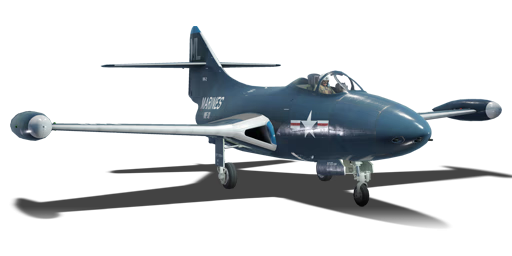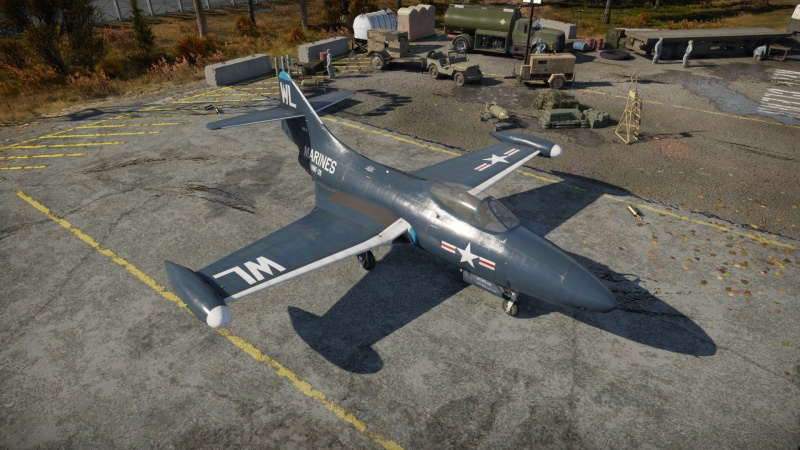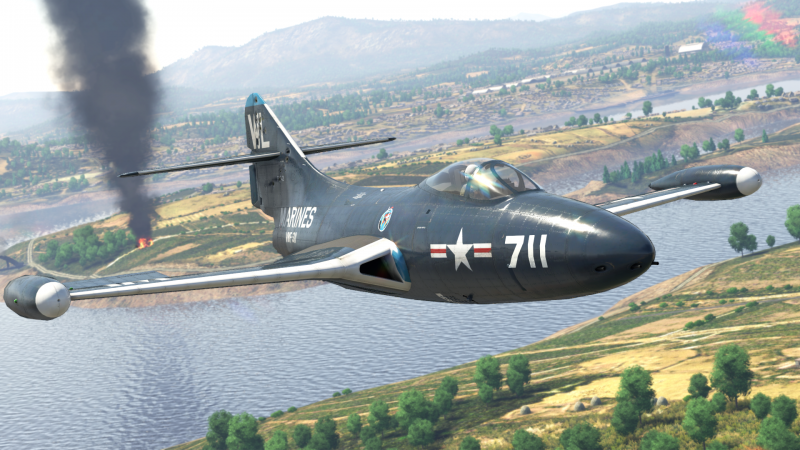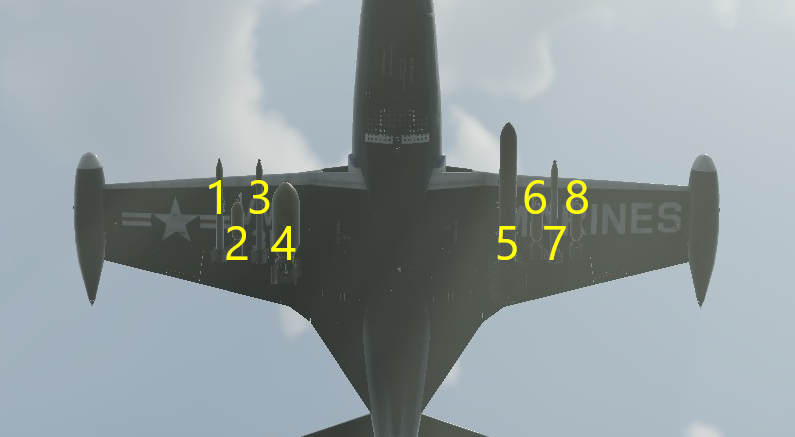Difference between revisions of "F9F-2"
(→Suspended armament: Updated) |
(→Description: updated) (Tag: Visual edit) |
||
| Line 12: | Line 12: | ||
== Description == | == Description == | ||
<!-- ''In the description, the first part should be about the history of and the creation and combat usage of the aircraft, as well as its key features. In the second part, tell the reader about the aircraft in the game. Insert a screenshot of the vehicle, so that if the novice player does not remember the vehicle by name, he will immediately understand what kind of vehicle the article is talking about.'' --> | <!-- ''In the description, the first part should be about the history of and the creation and combat usage of the aircraft, as well as its key features. In the second part, tell the reader about the aircraft in the game. Insert a screenshot of the vehicle, so that if the novice player does not remember the vehicle by name, he will immediately understand what kind of vehicle the article is talking about.'' --> | ||
| − | The | + | The Panther was born during a time when the jet engine was beginning to make its appearance into service. Grumman began work on the XF9F-1 Prototype that eventually was dropped in favour of the XF9F-2 prototype, Grumman's Model G79, that utilized 1 crew member and eventually a single-engine. As the Panther moved along the creation process, items like wingtip fuel tanks were added to increase its range. Carrier trials with the prototypes were completed in March of 1949. The F9F-2 entered US Navy service in May of 1949. The F9F-2 is the first production variant of the Panther. It is powered by a Pratt & Whitney J42-P-8, a license-built version of the Rolls Royce Nene engine. |
| − | The Panther will typically find itself outclassed as it often faces against more advanced jet designs, such as the [[MiG-15]] or [[Venom FB.4|Venom]]. However, it does excel in a support fighter role. Distracted opponents are easy prey when the Panther's high-speed driving and manoeuvrability are applied correctly. When engaged 1 on 1 with other jet fighters, its flaws (low top speed) can be exposed. Defensively, the Panther has an uncanny ability to escape pursuing enemies when using its agility to your advantage. The Panther greatly excels at the Fighter-bomber role due to its optional payloads. | + | It was introduced in [[Update 1.37]]. The Panther will typically find itself outclassed as it often faces against more advanced jet designs, such as the [[MiG-15]] or [[Venom FB.4|Venom]]. However, it does excel in a support fighter role. Distracted opponents are easy prey when the Panther's high-speed driving and manoeuvrability are applied correctly. When engaged 1 on 1 with other jet fighters, its flaws (low top speed) can be exposed. Defensively, the Panther has an uncanny ability to escape pursuing enemies when using its agility to your advantage. The Panther greatly excels at the Fighter-bomber role due to its optional payloads. |
== General info == | == General info == | ||
| Line 170: | Line 170: | ||
{{Navigation-Start|Default weapon presets}} | {{Navigation-Start|Default weapon presets}} | ||
{{Navigation-First-Simple-Line}} | {{Navigation-First-Simple-Line}} | ||
| + | |||
* Without load | * Without load | ||
* 6 x HVAR rockets | * 6 x HVAR rockets | ||
| Line 222: | Line 223: | ||
;Skins | ;Skins | ||
| + | |||
* [https://live.warthunder.com/feed/camouflages/?vehicle=f9f-2 Skins and camouflages for the {{PAGENAME}} from live.warthunder.com.] | * [https://live.warthunder.com/feed/camouflages/?vehicle=f9f-2 Skins and camouflages for the {{PAGENAME}} from live.warthunder.com.] | ||
Revision as of 18:55, 21 December 2023
| This page is about the American naval jet fighter F9F-2. For other versions, see F9F (Family). |
Contents
Description
The Panther was born during a time when the jet engine was beginning to make its appearance into service. Grumman began work on the XF9F-1 Prototype that eventually was dropped in favour of the XF9F-2 prototype, Grumman's Model G79, that utilized 1 crew member and eventually a single-engine. As the Panther moved along the creation process, items like wingtip fuel tanks were added to increase its range. Carrier trials with the prototypes were completed in March of 1949. The F9F-2 entered US Navy service in May of 1949. The F9F-2 is the first production variant of the Panther. It is powered by a Pratt & Whitney J42-P-8, a license-built version of the Rolls Royce Nene engine.
It was introduced in Update 1.37. The Panther will typically find itself outclassed as it often faces against more advanced jet designs, such as the MiG-15 or Venom. However, it does excel in a support fighter role. Distracted opponents are easy prey when the Panther's high-speed driving and manoeuvrability are applied correctly. When engaged 1 on 1 with other jet fighters, its flaws (low top speed) can be exposed. Defensively, the Panther has an uncanny ability to escape pursuing enemies when using its agility to your advantage. The Panther greatly excels at the Fighter-bomber role due to its optional payloads.
General info
Flight performance
| Characteristics | Max Speed (km/h at 0 m - sea level) |
Max altitude (metres) |
Turn time (seconds) |
Rate of climb (metres/second) |
Take-off run (metres) | |||
|---|---|---|---|---|---|---|---|---|
| AB | RB | AB | RB | AB | RB | |||
| Stock | 913 | 904 | 12500 | 27.3 | 28.6 | 19.8 | 18.3 | 750 |
| Upgraded | 939 | 926 | 26.8 | 27.0 | 34.1 | 26.5 | ||
Details
| Features | |||||
|---|---|---|---|---|---|
| Combat flaps | Take-off flaps | Landing flaps | Air brakes | Arrestor gear | Drogue chute |
| ✓ | ✓ | ✓ | ✓ | ✓ | X |
| Limits | ||||||
|---|---|---|---|---|---|---|
| Wings (km/h) | Gear (km/h) | Flaps (km/h) | Max Static G | |||
| Combat | Take-off | Landing | + | - | ||
| 1000 | 400 | 572 | 531 | 310 | ~9 | ~4 |
| Optimal velocities (km/h) | |||
|---|---|---|---|
| Ailerons | Rudder | Elevators | Radiator |
| < 620 | < 650 | < 700 | N/A |
Engine performance
| Engine | Aircraft mass | |||||||
|---|---|---|---|---|---|---|---|---|
| Engine name | Number | Basic mass | Wing loading (full fuel) | |||||
| Pratt & Whitney J42-P-8 | 1 | 4,833 kg | 325 kg/m2 | |||||
| Engine characteristics | Mass with fuel (no weapons load) | Max Takeoff Weight | ||||||
| Weight (each) | Type | 22m fuel | 30m fuel | 45m fuel | 60m fuel | 73m fuel | ||
| 600 kg | Centrifugal-flow turbojet | 5,650 kg | 5,942 kg | 6,496 kg | 7,051 kg | 7,555 kg | 9,636 kg | |
| Maximum engine thrust @ 0 m (RB/SB) | Thrust to weight ratio @ 0 m (WEP) | |||||||
| Condition | 100% | WEP | 22m fuel | 30m fuel | 45m fuel | 60m fuel | 73m fuel | MTOW |
| Stationary | 2,260 kgf | 2,599 kgf | 0.46 | 0.44 | 0.40 | 0.37 | 0.34 | 0.27 |
| Optimal | 2,260 kgf (0 km/h) |
2,599 kgf (0 km/h) |
0.46 | 0.44 | 0.40 | 0.37 | 0.34 | 0.27 |
Survivability and armour
- 9.5 mm Steel - Fore cockpit armour plate
- 9.5 mm Steel - Armour plate behind pilot's seat
- 60 mm Bulletproof Glass - Windshield
Modifications and economy
The primary modules that will need to be unlocked are flight performance, handling (New boosters), and Offensive 20 mm belts. After unlocking these high priority improvements, then the focus is secondary weaponry. Without the New 20 mm Cannons module the plane tends to have a high spread when firing its primary armament.
Armaments
Offensive armament
The F9F-2 is armed with:
- 4 x 20 mm M3 cannons, nose-mounted (190 rpg = 760 total)
Suspended armament
The F9F-2 can be outfitted with the following ordnance:
| 1 | 2 | 3 | 4 | 5 | 6 | 7 | 8 | ||
|---|---|---|---|---|---|---|---|---|---|
| 100 lb AN-M30A1 bombs | 1* | 1 | 1 | 1 | 1 | 1 | 1 | 1* | |
| 250 lb AN-M57 bombs | 1* | 1 | 1 | 1 | 1 | 1 | 1 | 1* | |
| 500 lb AN-M64A1 bombs | 1* | 1 | 1 | 1 | 1 | 1* | |||
| 1,000 lb AN-M65A1 bombs | 1 | 1 | |||||||
| HVAR rockets | 1* | 1 | 1 | 1 | 1 | 1* | |||
| Tiny Tim rockets | 1 | 1 | |||||||
| Maximum permissible loadout weight: 1,460 kg Maximum permissible wing load: 730 kg Maximum permissible weight imbalance: 450 kg | |||||||||
| * 500 lb bombs on hardpoints 2/7 cannot be equipped with ordnance on hardpoints 1/8 | |||||||||
| Default weapon presets | |
|---|---|
| |
Usage in battles
The F9F-2 is best described as a support fighter. It is often outclassed by more powerful enemies such as the MiG-15, but as a support to allies, it shines nonetheless. In this play-style, the Panther can leverage its desirable dive characteristics to prey on distracted opponents. A Panther pilot may often find themselves with an enemy on their six. In such a defensive situation, the F9F-2 provides an excellent roll rate with which to dodge enemy fire. However, to dispatch the opponent, it is often necessary to employ the help of teammates.
The Panther has a wide selection of ground-attack ordnance options and can use either bombs or rockets to destroy ground targets very effectively in ground realistic battles. In air battles, the Panther is in almost all cases better suited for an air-to-air role, but even when ordnance is not mounted, the internal 20 mm cannons are able to destroy lightly armoured ground targets. When using HVAR rockets, the aim is especially important, as the six rockets are fired in pairs. With only three shots, it is important to maximize the rockets' effectiveness by aiming slightly to the side of the target. Since the rockets are wing-mounted, this will result in one of them hitting the target directly and causing the maximum possible damage.
Pros and cons
Pros:
- Decent manoeuvrability at higher speeds
- Excellent roll rate
- Decent suspended armament
- Good low altitude performance
- Powerful armament with a high rate of fire
- High ammo capacity
- Large fuel capacity in comparison with other fighter jets
Cons:
- Poor high altitude performance
- Poor low-speed manoeuvrability
- Poor top speed
- Very fragile tail
- WEP runs out very quickly
- Battle rating puts the Panther against planes like the MiG-15bis, the MiG-17 and the Hawker Hunter, all of which outperform it
- Cannons are horribly inaccurate when stock
History
The Panther was born during a time when the jet engine was beginning to make its appearance into service. The United States Navy commissioned a jet-powered fighter for its carrier decks. Grumman began work on the XF9F-1 Prototype (Grumman designation G75). The airframe would carry two crewmen and implement four turbojet engines. At the time, four of them were planned to be used due to the low power output by early turbojet engines. This ran into several issues including taking up too much space on American carriers. Eventually, the design was dropped in favour of the XF9F-2 prototype, Grumman's Model G79, that utilized 1 crew member and eventually a single-engine. The British Rolls-Royce Nene turbojet engine was used for basic testing. Pratt & Whitney were eventually able to produce the engine and it was designated "J42". As the Panther moved along the creation process, items like wingtip fuel tanks were added to increase its range. Carrier trials with the prototypes were completed in March of 1949. The F9F-2 entered US Navy service in May of 1949.
The F9F-2 is the first production variant of the Panther. It is powered by a Pratt & Whitney J42-P-8, a license-built version of the Rolls Royce Nene engine. The F9F-2B was a new variant of the F9F-2 which allowed it to carry 2,000 lbs of ordnance under its wings. Once all F9F-2s were upgraded to the B standard, the B designation was dropped and the aircraft was simply referred to as F9F-2.
The Panther entered combat during the Korean War. It was the primary jet fighter used by the U.S. Navy and Marines. It played a significant part in the ground attack role and flew over 78,000 sorties. It secured the first U.S. Naval air to air kill against a Yak-9. Famous F9F pilots included astronaut John Glenn and Boston Red Sox player Ted Williams. Panthers were pulled from front-line service in 1956 in favour of the swept-wing "Cougar". F9F Panther was the first jet used with the US Navy's Blue Angels aerobatic team.
Media
- Skins
See also
External links
| Grumman Aircraft Engineering Corporation | |
|---|---|
| Aircraft | |
| Fighters | |
| F3F | F3F-2 · Galer's F3F-2 |
| F4F Wildcat | F4F-3 · F4F-4 |
| XF5F Skyrocket | XF5F · XP-50 |
| F6F Hellcat | F6F-5 · F6F-5N |
| F7F Tigercat | F7F-1 · F7F-3 |
| F8F Bearcat | F8F-1 · F8F-1B |
| Jet Fighters | |
| F9F Panther/Cougar | F9F-2 · F9F-5 · F9F-8 |
| F-11 Tiger | F11F-1 |
| F-14 Tomcat | F-14A Early · F-14B |
| Jet Strike Aircraft | |
| A-6 Intruder | A-6E TRAM |
| Bombers | TBF-1C |
| Export | ▄Martlet Mk IV · ▄F6F-5 · ▄F6F-5N · ▄F8F-1B · ▄Avenger Mk II · ▄Hellcat Mk II |
| ▄F-14A IRIAF | |
| Naval Vehicles | |
| Patrol Gunboat Hydrofoil (PGH) | USS Flagstaff |
| USA jet aircraft | |
|---|---|
| Fighters | |
| F9F | F9F-2 · F9F-5 · F9F-8 |
| F-80 | F-80A-5 · F-80C-10 |
| F-84 | F-84B-26 · F-84F · F-84G-21-RE |
| F-86 | F-86A-5 · F-86F-25 · F-86F-2 · F-86F-35 |
| F-89 | F-89B · F-89D |
| F-100 | F-100D |
| F-104 | F-104A · F-104C |
| F-4 | F-4C Phantom II · F-4E Phantom II · F-4J Phantom II · F-4S Phantom II |
| F-5 | F-5A · F-5C · F-5E · F-20A |
| F-8 | F8U-2 · F-8E |
| F-14 | F-14A Early · ▄F-14A IRIAF · F-14B |
| F-15 | F-15A · F-15C MSIP II · F-15E |
| F-16 | F-16A · F-16A ADF · F-16C |
| Other | P-59A · F2H-2 · F3D-1 · F3H-2 · F4D-1 · F11F-1 |
| Strike Aircraft | |
| FJ-4 | FJ-4B · FJ-4B VMF-232 |
| A-4 | A-4B · A-4E Early |
| A-7 | A-7D · A-7E · A-7K |
| AV-8 | AV-8A · AV-8C · AV-8B Plus · AV-8B (NA) |
| A-10 | A-10A · A-10A Late · A-10C |
| F-111 | F-111A · F-111F |
| Other | A-6E TRAM · F-105D · F-117 |
| Bombers | |
| B-57 | B-57A · B-57B |







